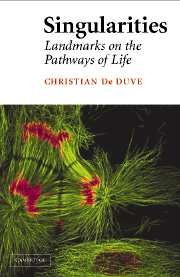Book contents
- Frontmatter
- Contents
- Foreword
- On Christian de Duve: An Editor's Appreciation
- General Introduction
- 1 Building Blocks
- 2 Homochirality
- 3 Protometabolism
- 4 ATP
- 5 Electrons and Protons
- 6 Thioesters
- 7 RNA
- 8 Proteins
- 9 DNA
- 10 Membranes
- 11 Protonmotive Force
- 12 Protometabolism Revisited
- 13 The LUCA
- 14 The First Fork
- 15 Eukaryotes
- 16 Oxygen
- 17 Endosymbionts
- 18 Multicellulars
- 19 Homo
- 20 Evolution
- Final Comments
- Bibliography
- Index
Foreword
Published online by Cambridge University Press: 18 January 2010
- Frontmatter
- Contents
- Foreword
- On Christian de Duve: An Editor's Appreciation
- General Introduction
- 1 Building Blocks
- 2 Homochirality
- 3 Protometabolism
- 4 ATP
- 5 Electrons and Protons
- 6 Thioesters
- 7 RNA
- 8 Proteins
- 9 DNA
- 10 Membranes
- 11 Protonmotive Force
- 12 Protometabolism Revisited
- 13 The LUCA
- 14 The First Fork
- 15 Eukaryotes
- 16 Oxygen
- 17 Endosymbionts
- 18 Multicellulars
- 19 Homo
- 20 Evolution
- Final Comments
- Bibliography
- Index
Summary
This book was not meant to happen. When I finished Life Evolving (de Duve, 2002), I resolved not to write another book. In that work, and in the three that preceded it (de Duve, 1984, 1991, 1995), I had written all I had to say on the subject of life, including its nature, origin, and evolutionary history, up to and beyond the advent of humankind, and even its cosmic significance. In fact, I made the embarrassing discovery, when called upon to reread some passages of these books, that I tended to repeat myself, sometimes using almost the same words – an ominous sign indeed.
I changed my mind and began writing this book when I discovered that, in trying to reach a wide readership, I had buried a number of scientific points that I felt to be significant and original within more general expositions designed for lay readers. The message I wished to convey had been blurred, even misinterpreted as reflecting the pursuit of an ideological agenda (Szathmary, 2002; Lazcano, 2003).
This realization has prompted me to clarify my thoughts, remove extraneous material, and formulate the result concisely for a scientifically literate readership. My aim is to reach not just my fellow biologists but all those scientists, from physicists, cosmologists, and geologists to naturalists and anthropologists, who share an interest in the place occupied by life, including our own, in the cosmos.
- Type
- Chapter
- Information
- SingularitiesLandmarks on the Pathways of Life, pp. vii - ixPublisher: Cambridge University PressPrint publication year: 2005

